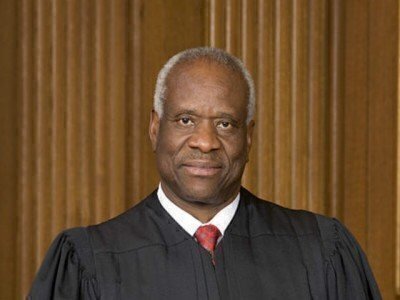Lyle Denniston, the National Constitution Center’s constitutional literacy adviser, looks at Wednesday’s Supreme Court decision about voting districts in Alabama and Justice Clarence Thomas’s opinions about race as a voting factor.
 “I do not pretend that Alabama is blameless when it comes to its sordid history of racial politics. But, today the state is not the one that is culpable. Its redistricting effort was indeed tainted, but it was tainted by our voting rights jurisprudence and the uses to which the Voting Rights Act has been put. Long ago, the Department of Justice and special-interest groups like the American Civil Liberties Union hijacked the Act, and they have been using it ever since to achieve their vision of maximized black electoral strength, often at the expense of the voters they purport to help…I continue to disagree with this court’s misguided and damaging jurisprudence.”
“I do not pretend that Alabama is blameless when it comes to its sordid history of racial politics. But, today the state is not the one that is culpable. Its redistricting effort was indeed tainted, but it was tainted by our voting rights jurisprudence and the uses to which the Voting Rights Act has been put. Long ago, the Department of Justice and special-interest groups like the American Civil Liberties Union hijacked the Act, and they have been using it ever since to achieve their vision of maximized black electoral strength, often at the expense of the voters they purport to help…I continue to disagree with this court’s misguided and damaging jurisprudence.”
– Justice Clarence Thomas, in a dissenting opinion for himself as the Supreme Court on Wednesday ordered a federal trial court in Alabama to reconsider claims that legislative leaders packed too many black voters into new legislative districts following the 2010 Census.
WE CHECKED THE CONSTITUTON, AND…
No one doubts that, at least since the 14th Amendment was put into the Constitution in 1868, states have been forbidden to discriminate on the basis of race in public policy. In modern times, however, America has struggled not over the necessity for states (and the national government) to end racial discrimination, but over how to do that without engaging in a new form of race-driven government programs. In other words, when can race be used as a remedy?
The Supreme Court, of course, has been in the middle of that struggle, and the Justices are still finding their way through the constitutional thicket of what might generally be called “affirmative action” – that is, devising legal (and constitutional) norms on when it is permissible to take race into account. Justice Clarence Thomas has been acting as a kind of solitary sentinel against too much of that, even to the point of arguing that the most important civil rights law in history – the Voting Rights Act of 1965 – is itself unconstitutional. No other member of the court has agreed with him on that.
Justice Thomas was on guard again on Wednesday, when the court tried once more to sort out the use of race in drawing new election districts. The particular problem before the court in an Alabama case was what is called “racial gerrymandering,” and, a variation on that problem, the “packing” of minority voters into ever more minority-dominated districts.
In a series of decisions over the years, the court has made clear that it is unconstitutional for a legislature to draw up new election boundaries if race was the “predominant factor” in the shaping of the districts. That is a constitutional concept. When that idea first emerged, it embodied the court’s worry that legislators were trying to keep minority voters from having any significant influence on who gets elected; the court would not tolerate the attempt not just to marginalize black voting strength, but to neutralize it altogether.
When the Voting Rights Act of 1965 came along, Congress mandated the consideration of race in all voting procedures, including the drawing of new districting maps. This was a form of affirmative action, and it definitely worked to increase minority voting strength, and hundreds of minority candidates got elected, even in the states of the old Confederacy.
More recently, the court has cut back sharply on the scope of the 1965 act, in particular by striking down the formula that Congress used to make it more difficult for states – especially in the South – to engage in race discrimination in election procedures. But the core obligation of the states under that law has remained: they cannot adopt voting policies that diminish the existing voting strength of minorities.
The Alabama case that the Justices have just decided tested how the court would deal with a relatively new kind of “racial gerrymandering.” Under this tactic, minority voters would be packed into an isolated number of districts – sometimes, in Alabama, the result was a district with more than 70 percent minority voting population. The aim was to isolate their strength, so that, statewide, they would not be able to have a genuine influence in shaping the control of state legislative chambers.
Most recently, in Alabama, the Republican-dominated legislature engaged in that form of “packing” in order to minimize Democratic electoral successes, on the understanding that most minority voters would vote Democratic.
In ordering a lower court to take a new look at Alabama’s latest state legislative redistricting maps, the Supreme Court strongly hinted that there had been too much “packing” and that, very likely, it resulted from the forbidden use of race as the “predominant factor.” The court, by a 5-to-4 vote, indicated that the legislature was wrong in trying to justify those maps by claiming they were only trying to obey the Voting Rights Act’s mandate not to diminish minority voting strength. That, the majority said, is not an excuse for drafting districts out of a racial motive.
Justice Thomas dissented from that ruling, partly by joining a dissenting opinion for three other Justices disputing the specifics of the Alabama lawsuit, but more importantly by writing his own, separate dissenting opinion to protest that the court itself had promoted the use of race as a controlling factor in election law.
“We have somehow arrived at a place,” Thomas wrote, “where the parties agree that Alabama’s legislative districts should be fine-tuned to achieve some ‘optimal’ result with respect to black voting power; the only disagreement is about what percentage of blacks should be placed in those optimized districts. This is nothing more than a fight over the ‘best’ racial quota.”
The Justice thus made clear that, even though he remains the only voice on the court for calling a halt to the race-in-politics legal experiment, he will eagerly try to keep the conversation going on that sensitive question.






